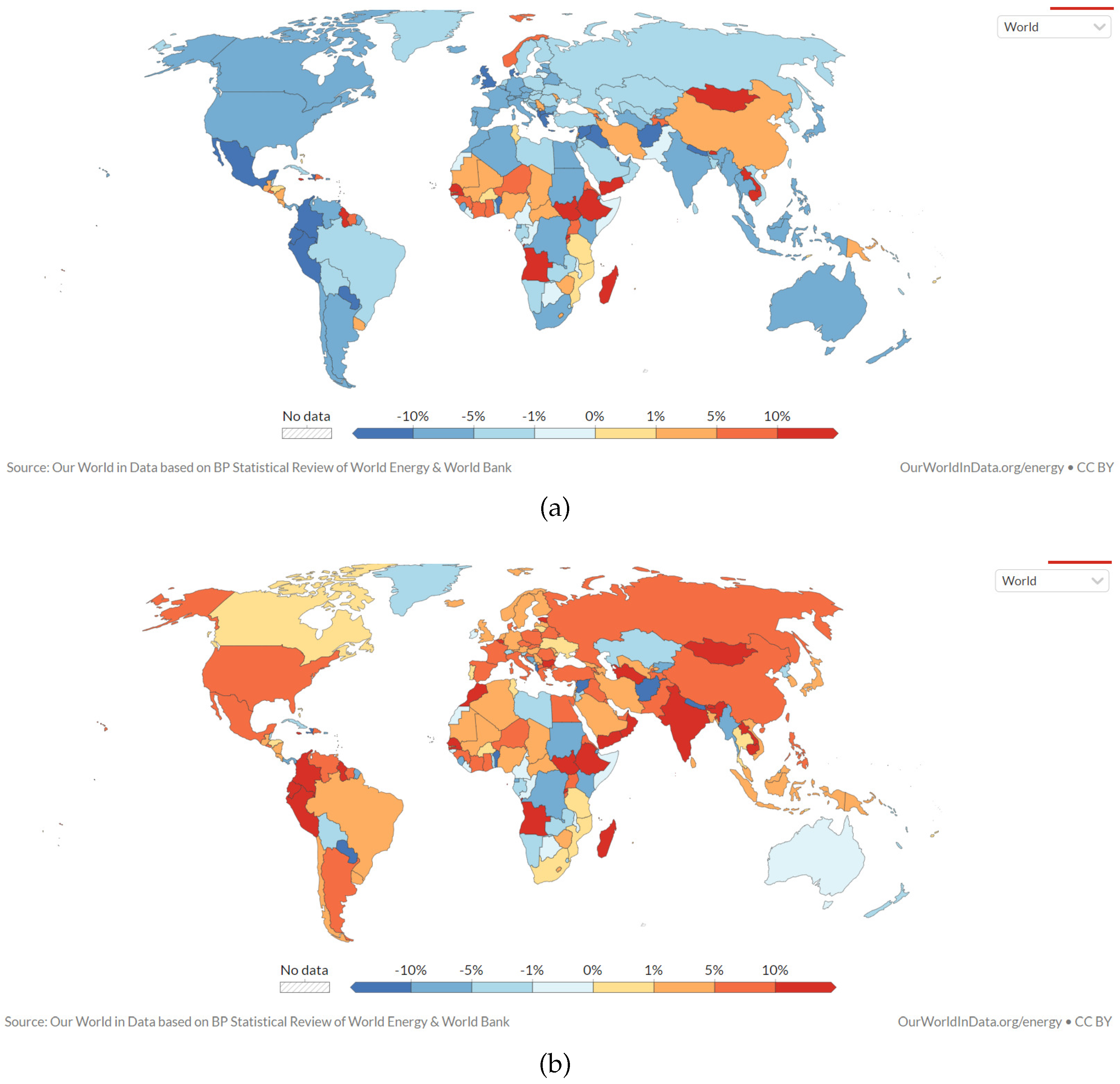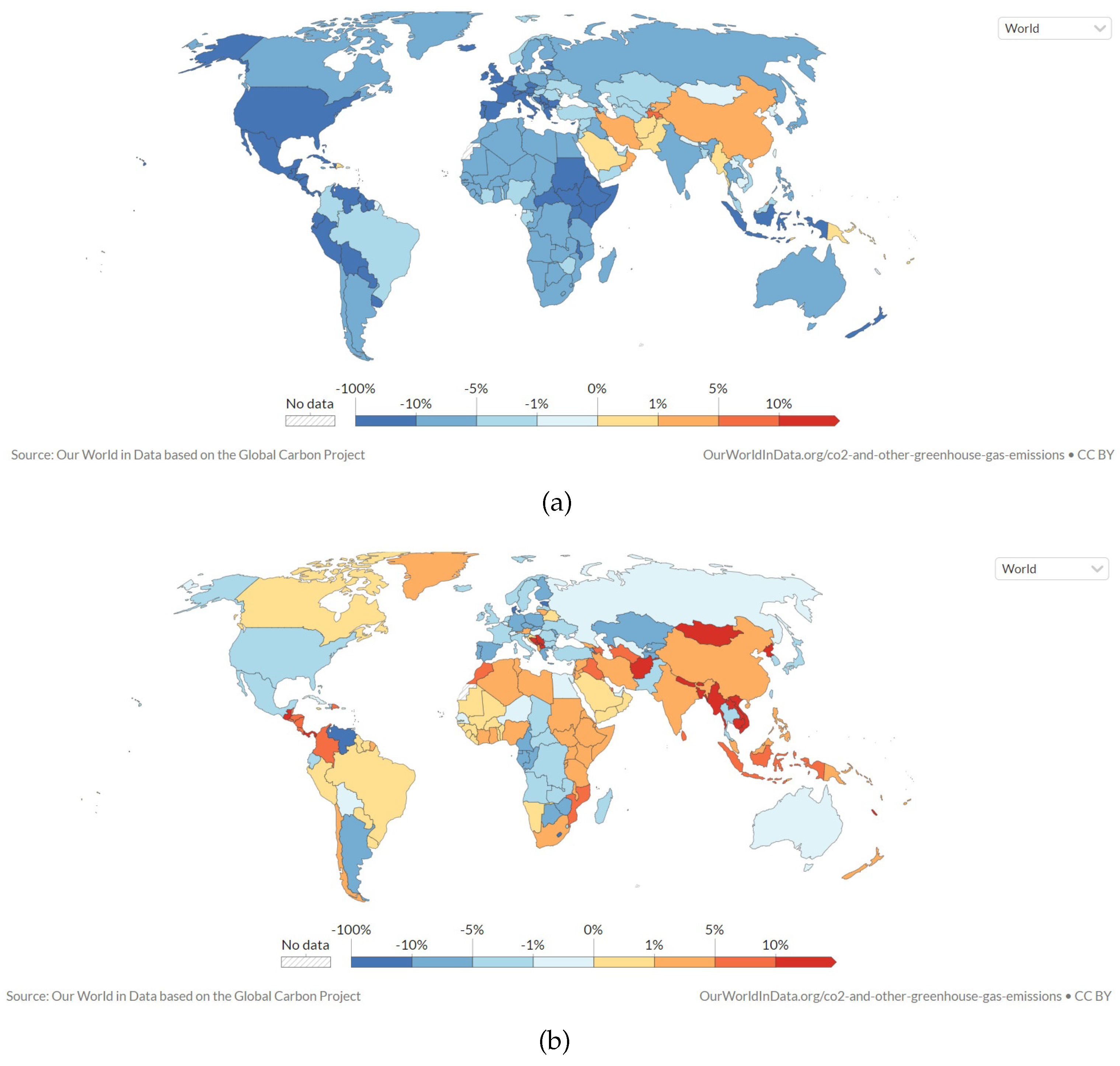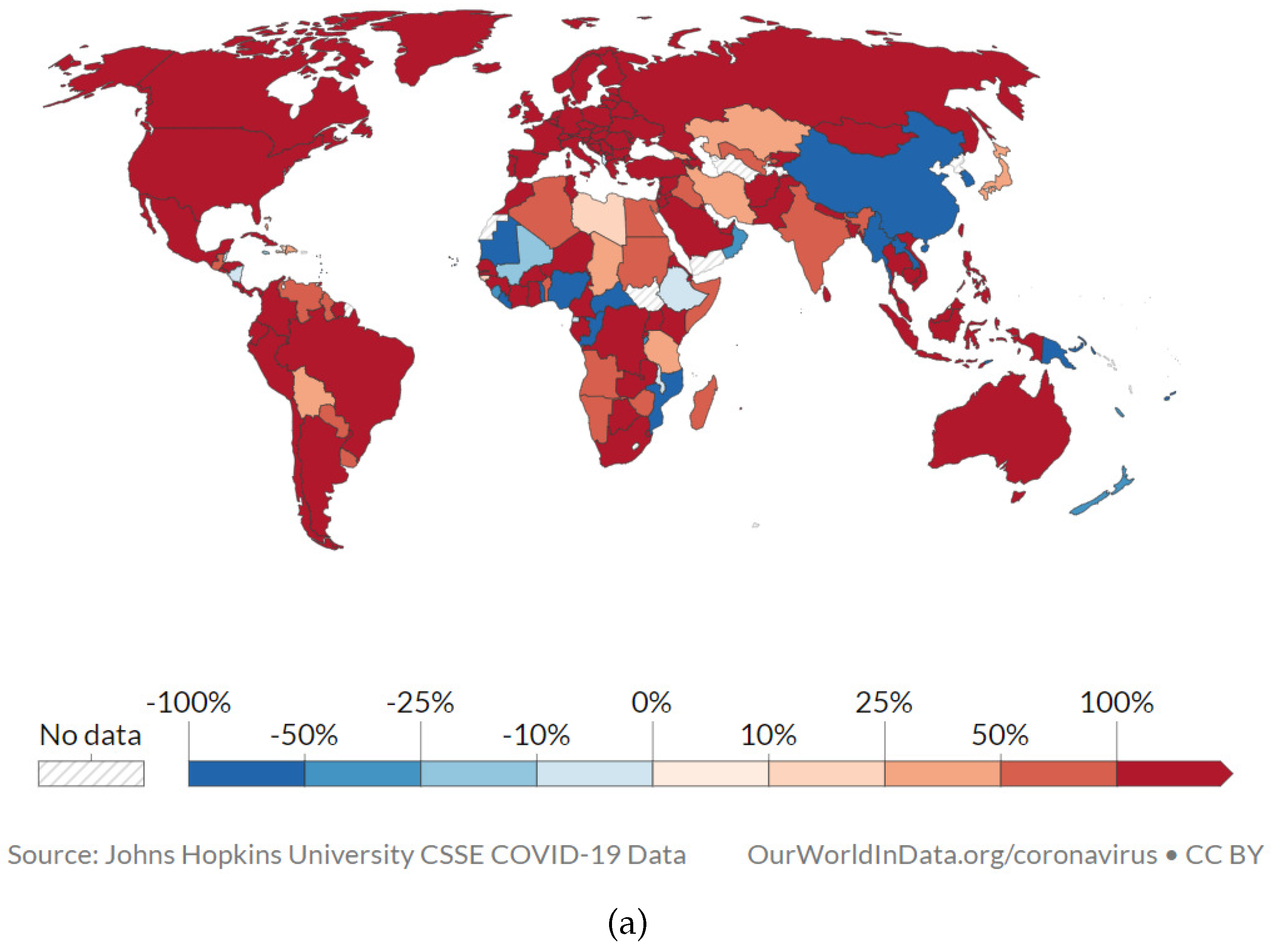The world is currently in the age of energy. At the same time, it is also the climate change era. The effects of the negative actions on the planet due to the increasing energy rate each year are today evident. Any action that can lead to a decrease in CO
emissions are welcome. Any activity including circular economy must be promoted. It is today the mission of the engineers to review their projects in order to increase the planet sustainability. From the data reported in [
1,
2,
3], and shown in the
Figure 1,
Figure 2 and
Figure 3, it appears that the total energy consumption in the world is an indicator of the economic status of each country and also gives a picture of the impact that some events, including the global outbreak of the COVID-19 pandemic, characterized the energy trends in each part of the world. We do not yet have data for the current year about the energy crisis and its cost that was caused by the Russia–Ukraine war, moreover, the economic and the social impacts are just evident looking both at the actions of governments, that tends to control the price of the energy, and the negative social effects.
The Energy Plant is a global interconnected system and, together with the telecommunication systems, requires real-time actions to ensure efficiency and reliability. Moreover, the Energy Plant is strongly constrained by the primary energy providers and the energy distribution system must provide the difficult tasks related to implement dispatching and energy saving systems. Adding to the previous difficulties, the future efforts must be performed to create and integrate sustainable energy systems in the existing grid, with the aim of decreasing the negative impacts of CO on the planet. In this Editorial, starting from the previous considerations, 19 papers are considered, recently published in the journal and related to some peculiar problems in conceiving renewable sustainable energy systems. The Editorial will remark upon some of the important topics included within and the efforts to stimulate research contributions in this area and to consider the fundamentals of energy studies in each researcher’s life.
The energy topic, in fact, is multidisciplinary and regards not only technical aspects, but first of all social and economic aspects. The tremendous positive impact that renewable energy may have on the quality of life in each country of the world can elicit hope for the future of the World.
A top–down scheme order is adopted in the discussion of the paper. The Editorial is organized as follows. The first paper [
4] regards energy and climate change. The Editorial will start with discussing papers related to material technologies [
5,
6]. The impact of the control strategies, local and global, referring the complex wind system will be then analyzed [
7,
8,
9,
10,
11,
12,
13]. The realization of photovoltaic systems integrated with the network is commented upon in [
14]. The original aspect of considering hybrid photovoltaic systems in marine transportation is then discussed [
15]. The real perspectives of fuel cell systems is briefly presented in the discussion of the contribution [
16]. The subject of the evaluation of economic investments in wind and in renewable energy is dealt with in the contributions [
17,
18,
19]. The papers [
20,
21,
22] regard the global perspectives of the decarbonization process and the impact that the renewable energy will have in the economies of particular countries and in the whole world.
In the contribution by Olabi and Abdelkareem [
4], the authors give focus to the correlation between renewable energy and their positive impact upon climate change. The subject is a guide for approaching and remarking on the successive papers considered in the Editorial. Starting from the policies and the studies on renewable energies and greenhouse gases, the authors present the technology advancements that have been recently completed. New hydro-energy turbines, ocean energy apparati, are mentioned. Biomass, solar energy, fuel cells, and wind systems require accurate models and control systems, which is an aspect that is also mentioned in the contribution. Moreover, CO
capture in high-energy plants is a key method for decreasing the possibility of changes in the planet’s climate. The key conclusions of the authors is that combined actions must be adopted and optimized for achieving both good energy production levels and environmental protection.
The main topic discussed in the paper by Pasupathi et al. [
5] regards the integration of solar thermal systems with sustainable energy storage materials. The contribution aims at improving phase change materials (PCM), including nanoparticles of SiO
and CeO
, allowing the increase in the performances of the thermal process at low temperatures. The experimental models on the material are widely presented. The chemical stability and the thermal conductivity are tested with accuracy by using advanced techniques in science material laboratories. The PCM-based energy system configuration is presented also in the paper by Prieto and Cabeza [
6], where the study has been performed by using salt-based PCMs diffused in commercial plants. The results are analyzed from an economical point of view, showing the improvements gained by using PCM-based systems with respect to the traditional ones. The contribution [
6] reinforces the studies performed in [
5], addressing the researchers to investigate details of the suitable materials that improve solar energy production. This is a good challenge for the future.
At present, several plants based on wind systems are in operation in the world. Wind pumps and wind power plants are generally the most successfully used, being essentially
green both in their use and in their fabrication processes. Moreover, their non-linear behavior, the strong non-linearities in the model, need accurate, and possibly new, control strategies. The variability of the wind intensity and direction makes the control aspects the core for an efficient behavior of wind-based energy systems. In the contribution [
7] by Sami et al., an innovative super twisting algorithm for utility grid connected 2 MW DFIG-WECS system is proposed. Both the mathematical model of the system, based on a fractional order model and a sliding mode control strategy are presented allowing the achievement of appealing results in term of efficiency. The numerical results obtained with Matlab/Simulink tools give good perspectives of success in the control of real processes. The results presented in [
7] increase the advanced control interest for Double-fed Induction Generator (DFIG) that are emphasized in a classical paper by Yang et al. [
8], where the high penetration of wind turbine had been widely studied with the aim of designing high-performance controllers based on classic models, addressing also grid fault conditions.
The frequency control of micro-grids with wind DFIGs is presented in the contribution by Gomez et al. [
9], where this important problem is approached by using battery energy storage systems (BESS). Energy penetration requires an accurate and continuous frequency monitoring and control, it is, therefore, fundamental that a continuous frequency drift evaluation and the use of appropriate embedded sensors [
13]. The problem of the frequency control is a key point problem in wind systems, due to the unpredictable fluctuations of the wind. The authors of the contribution [
9] propose to include a BESS in a classical DFIG system adopting an appropriate mathematical model and a control strategy that is based on handling the battery energy storage in order to achieve the frequency control of the electrical power signal.
The efficient use of wind energy to pump water and, therefore, the use of coupling wind and hydro-electrical energy production is presented in the contribution by Nikolaou et al. [
10] by referring to a case study developed in Crete. In particular, the site is that of POTAMON and the plant is a recent hydraulic project. The paper includes an accurate model of the system and a mathematical model for the optimization. The plant does work in an isolated grid. The approach of [
10] is also mentioned in the paper [
11] by Caralis et al., where the whole Greece power supply system is considered. In the same contribution, the problem is widely analyzed in the context of a global simulation of the Greek power supply system taking also into account the solar energy integration. The problem is also faced in terms of tariffs regulation. Differently from the case studied in [
10], more pump equipments are, of course, considered.
In order to improve the penetration of wind renewable energy, the Low Voltage Ride Through (LVRT) strategy is discussed in the contribution by Mahela et al. [
12]. The LVRT is fundamental in the case of grid fault events. It permits to avoid the shutdown and the related drawbacks in large-scale wind power plants. The detailed report reviews the complete state of the art on the subject, including about 200 papers. The paper presents, also, a comparison between LVRT systems and FSWG (Fixed Speed Wind turbine Generators). The authors report, also, a summary of the common control strategies for LVRT systems. The study is made in agreement with the international performance standards.
The penetration of solar-photovoltaic systems in the power networks also includes an accurate design of fault diagnosis systems. In the paper [
14], by Kulshrestha et al., the authors report an interesting fault recognition algorithm, including an accurate mathematical definition of the fault indices. In the paper, a fault index based on the Wigner Distribution, a fault index based on Stockwell Transform, and an index that is the combination of the previous two have also been considered. A modified IEEE-13 Node standard distribution network is considered for testing the algorithm. Various operative conditions are reported. The performances are also evaluated in a noisy environment.
The presence of renewable energy plants in the marine transportation system is of high and increasing interest. The topic of the contribution by Yang et al. [
15] is related to the study of an hybrid system based on a photovoltaic plant and a diesel electrical power generator to handle the energy in a ship. The paper is timely and includes detailed items, among them the accurate mathematical modeling that allow for an optimization of the energy resources of the global system. Moreover, the numerical results lead to improve continuously the management of the apparatus considering also the battery accumulation system.
The fuel cell systems play a fundamental role in the future of renewable energy for the decarbonization in the world. In the paper [
16] by Cigolotti et al., the positive impressive scenario of the fuel cell plants is reported. In particular, various technologies are discussed, and the increasing number of fuel cell plants in the world is widely remarked. The study of cost evaluation is clearly presented.
As occurs with new plants installation of any type, renewable energy plants require an accurate economic analysis. Both the contributions [
18] by Qiu et al., and [
19] by Strantzali and Aravossis, are focused upon this aim. The contribution [
18] remarks the aspects of risk investments, moreover it presents an innovative strategy based on the fuzzy logic theory in order to develop a highly reliable and flexible tool for a correct financial risk evaluation. More evaluations are derived in order to establish some useful guidelines in this topic. The study is devoted to the wind energy system, moreover the techniques presented are quite general.
An intense review on the decision-making problems in the area of renewable energy investments is reported in the paper [
19], where more strategies based on multi-objective optimization are reported, involving environmental, economic, and social aspects. Moreover, the paper gives a complete guideline to conceive a complete state of the art on the problem. Recently, an appealing study on the subject, regarding the risk profile both for renewable energy sources and for the fossil power sector, has been proposed by Shrimali [
17].
The study presented in the paper by Chu et al. [
20] gives a complete recent review on the topic of sustainable energy systems; in particular, the authors summarize selected contributions presented during the 14th SDEWES Conference on sustainable development, held in Dubrovnik in 2019. The paper covers topics not only mentioned renewable energies and it mentions the concept of conceiving energy-saving systems and appropriate hybrid solutions for heating and cooling buildings. Moreover, in the paper the topics of innovative tri-generation systems in nuclear-hybrid renewable energy plants are outlined, as a further contribution to the decarbonization.
A real case-study on how to integrate in the grid renewable energy is presented in the paper by Barrozo Budes et al. [
21]. The authors mention that the appropriate software system HOMER allows the optimization of the considered hybrid system. The specific application is referred to the La Guayan power plant in Columbia. The problem is addressed to the optimal combination of the energy sources in order to satisfy the demand and to reduce the CO
emissions. The combination of energy data with meteorological information is a key point for the success of the initiative.
In the contribution [
22] by Korkmaz et al., the authors, starting from the Paris Agreement, present an integrated assessment toolbox for the European Energy Global System. The main task is to approach the decarbonization by using an analysis based on the decomposition strategy. The link between the energy system and the impact on health are presented. Unfortunately, the paper does not take into account the fragility of the European Energy System with respect to the Energy suppliers. This is very clear now, as of October 2022.
The Editorial has been conceived in order to remark various items related to the renewable energy problems choosing only a limited numbers of papers that focalize some of the main subjects of the topic. The special case of energy production from nuclear fusion experiments has not been considered in this Editorial, yet it is considered a renewable energy source, as it is still in its early stages and multidisciplinary technological problems are today faced in several projects, involving researchers throughout the planet and aiming at building novel generation fusion reactors, such as DTT, ITER, and DEMO [
23]. Moreover, the Editorial tends to remark that the problem of renewable energy does include local actions and global actions, in order to give a real positive perspective for the survival of the world.









